Olaf Danielson's Blog, page 12
March 11, 2019
Following the last trail of Ernest Shackleton
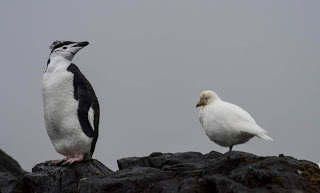 MEN WANTED for hazardous journey, small wages, bitter cold, long months of complete darkness, constant danger, safe return doubtful, honor and recognition in case of success. ...or so the advertisement by Shackleton went, who would place such an ad?
MEN WANTED for hazardous journey, small wages, bitter cold, long months of complete darkness, constant danger, safe return doubtful, honor and recognition in case of success. ...or so the advertisement by Shackleton went, who would place such an ad?ERNEST SHACKLETON was without a doubt one of the craziest thrill seekers of his generation. probably the last of his kind following in the footsteps of Scott and Amundson. Involved with the early attempts to reach the south pole, he held for a time the distinction of being the the person to have stood the farthest south on Earth. Roald Amundson broke that record in 1911, reaching the pole and from that point on, Shackleton concentrated on being the first person to cross Antarctica on foot.He is most famous for his Endurance voyage of 1914-17, which ended when the ship got stuck in pack ice and was destroyed leaving the crew to encamp on the ice until it melted and then he with four people was forced to sail in a small boat 700 nautical miles to South Georgia island in a converted 20 foot life raft, and encountering a storm so fierce it sunk other larger ships in nearby waters, but this was his only plan to get help. The final leg, was a tough 36 hour crossing of the island to a whaling station on the other side overland using only a 50 foot piece of rope. It became the end of his most famous journey. In fact, even the crossing of South Georgia was not undertaken again for 40 years when a more modern explorer did it. “I do not know how they did it, except they had to.” Was a quote from Duncan Carse, the only other man to have done what Shackleton did. Shackleton then organized the rescue of everyone in his expeditionShackleton was listless and unhappy away from his exploring and by 1921, after some work in the Russian Civil War, he was ready to head south again, for another attempt to cross Antarctica, but he never made it to the southernmost continent. This time fate took him and he died of a heart attack in Grytviken Harbor in January 5, 1922. He was five weeks short of his 48thbirthday.It was two months over 97 years later that I followed in his footsteps and on march 10, landed in Grytviken harbor. The place was now as much of a historical preservation location as the whaling station had been closed 50 years previous. The wholesale slaughter of blue whales thankfully ended.Shackleton’s body made it’s way to Montevideo, Uruguay where we started our trip in the southern hemisphere before a message from his wife requesting that he be buried in South Georgia was received. The body was brought back to the island aboard the steamer Woodville and buried on March 5th, 1922. The Boss as he was known would only have been happy being buried at a place near where he finished one of his greatest exploits. Unlike everyone else in the cemetery
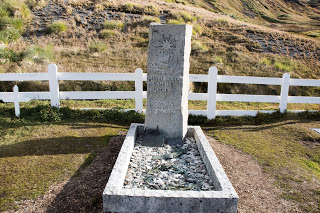 Yesterday, we toasted the great explorer, dumping a little Jameson Whiskey out for "The Boss"
Yesterday, we toasted the great explorer, dumping a little Jameson Whiskey out for "The Boss"
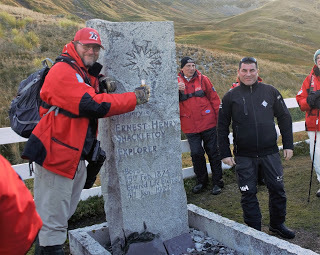 Olaf and Captain Debien toasting Shackleton at a graveside ceremony, five days late of the 97th anniversary of his burial
Olaf and Captain Debien toasting Shackleton at a graveside ceremony, five days late of the 97th anniversary of his burialThe views of South Georgia when the sun is out (and that is about 20% of the time) is stunning. The island has sheer snow capped mountain precipices, and fjords, and is surrounded by occasional iceberg. We spent parts of three days exploring it, which unfortunately for me was somewhat limited as I had picked up a virus from some passenger and I was nursing a fever and bronchitis while we were there. It is true that I frequently say, the birding must go on, and it did, although at one stunning backdrop our trip to shore was without me, I stayed aboard ship, helped an elderly German man with his camera, and scoped snowy sheathbills from my balcony. Hopefully not sharing my virus, but hard to tell. But I got out and tallied all the birds I needed, finally helping my friends get them all too. It was a potpourri of southern species
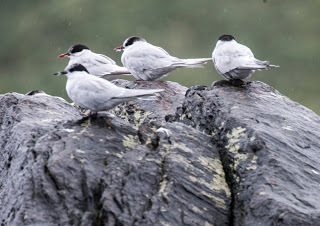 Antarctic terns
Antarctic terns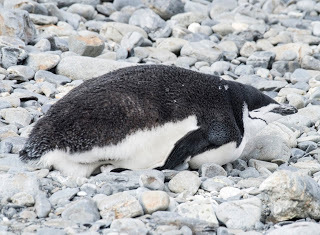 Napping Chinstrap penguin, Penguin #6 for trip
Napping Chinstrap penguin, Penguin #6 for trip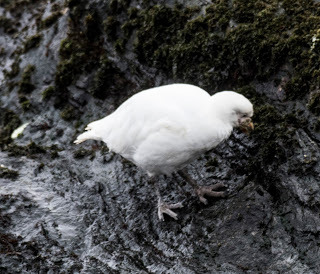 Snowy sheathbill, which are really odd birds, sort of related to sandpipers
Snowy sheathbill, which are really odd birds, sort of related to sandpipers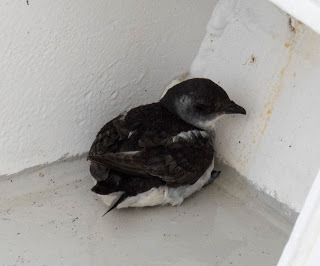 I found this endemic South Georgia diving petrel when the crew was preparing the ship for incredible rough seas ahead. We got him out before he would be crushed by huge swells breaking in the foredeck. I did a good deed and also got a lifer bird. I saw more later off the deck, but I almost got blown overboard
I found this endemic South Georgia diving petrel when the crew was preparing the ship for incredible rough seas ahead. We got him out before he would be crushed by huge swells breaking in the foredeck. I did a good deed and also got a lifer bird. I saw more later off the deck, but I almost got blown overboard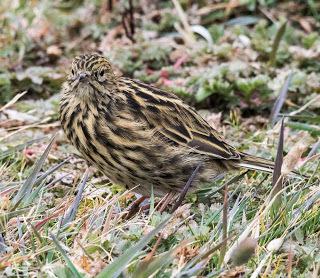 South Georgia pipit
South Georgia pipit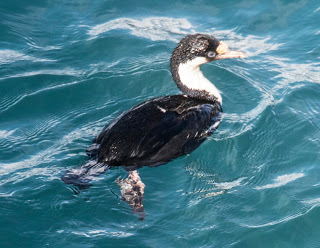 South Georgia shag
South Georgia shag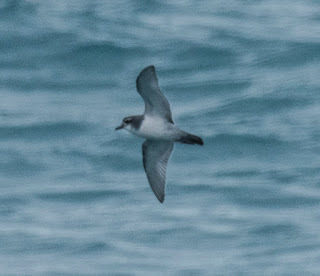 Antarctic prion
Antarctic prion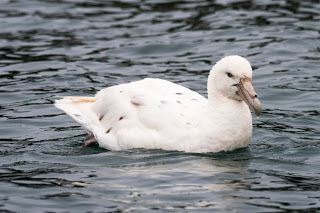 Southern giant petrel, white phase
Southern giant petrel, white phase Black bellied storm petrel
Black bellied storm petrel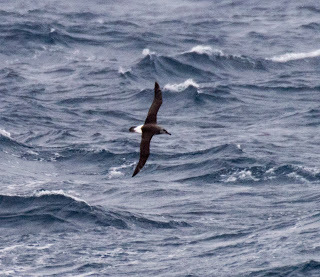 Gray headed albatross
Gray headed albatross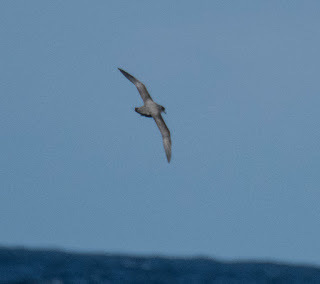 Gray petrel
Gray petrel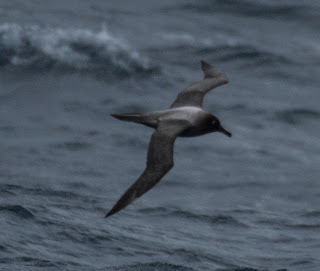 light mantled albatross
light mantled albatross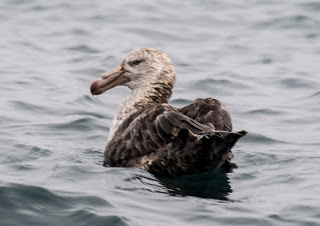 Northern giant petrel
Northern giant petrel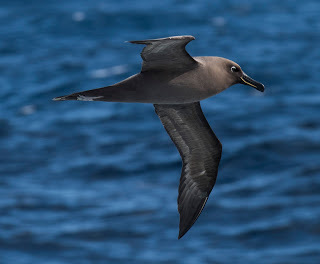 Sooty albatross
Sooty albatross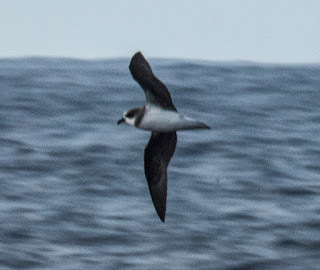 soft plumaged petrel
soft plumaged petrelExcept for not seeing a snow petrel off the huge iceberg, on our final pass out of South Georgian waters I got all the birds I needed to get here. With that I still left something for next time. Snow petrel will have to wait for another time
There were other sights to see around South Georgia Island
 HMS Clyde at Grytviken
HMS Clyde at Grytviken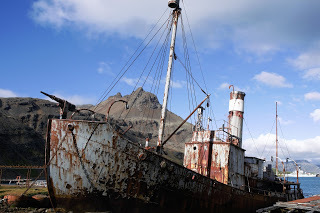 view of Grytviken
view of Grytviken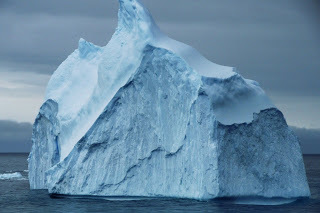
 Leopard seal before he attacked a zodiac
Leopard seal before he attacked a zodiac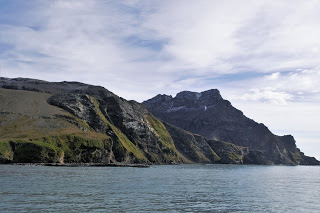
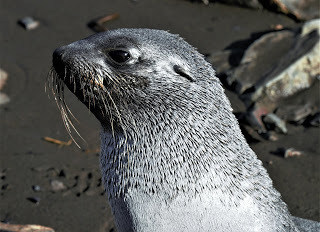 Fur seal pup
Fur seal pup
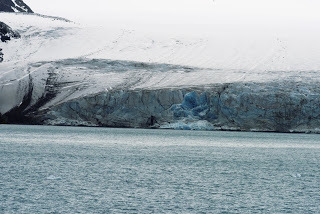 Glacier at Larsen Bay
Glacier at Larsen BayYesterday was the best day all year in South Georgia, but alas, not today, today we are sailing into the unknown, through this fjord and into 50 mph winds, the ship is listing due to the wind. The captain secured everything, as 8 meter waves crash on the foredeck, as we head to Trisdan de Cuhna, I'm drinking and it isn't even noon yet. I'm not drinking due to lifer bird although I got the diving petrel today, but because I'm a little scared, and even I put a patch on, the first time I have since my 2013 voyage to Attu.
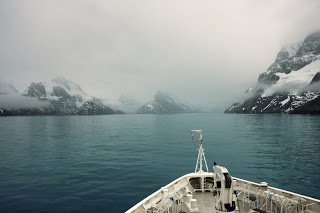 Farthest point south in my life just at 55 degrees, which a few minutes later matched the wind speed
Farthest point south in my life just at 55 degrees, which a few minutes later matched the wind speedWaves are breaking on top of 6th deck, and so for now, I must sign off,
Olaf from the South Atlantic
Published on March 11, 2019 06:38
March 7, 2019
Desire the Right
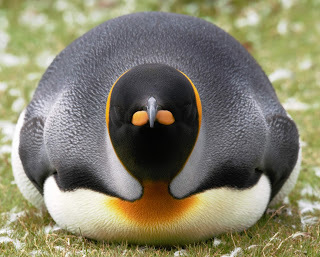 In 1596 a British Sailor named John Davis aboard the Desire spotted for the first time the Falkland Islands. It was nearly 80 years later when another Brit, a man named John Strong actually landed on the island, and curiously the first settlement on the island was by a French Explorer named a man named Bougainville in 1765. British troops in 1832 and 1833 removed an Argentine occupation and began a 185 year protest by the Argentines as to the rightful ownership of the islands, which remain British, despite a 1982 war.
In 1596 a British Sailor named John Davis aboard the Desire spotted for the first time the Falkland Islands. It was nearly 80 years later when another Brit, a man named John Strong actually landed on the island, and curiously the first settlement on the island was by a French Explorer named a man named Bougainville in 1765. British troops in 1832 and 1833 removed an Argentine occupation and began a 185 year protest by the Argentines as to the rightful ownership of the islands, which remain British, despite a 1982 war.The British Overseas territory now has the motto "Desire the Right" in honor of that first ship firmly stated on their flag which has the Union Jack and a sheep on its flag. The are 3400 residents and many tens of thousands of sheep that make the island home.
With this in mind, three days ago, our expedition mad four stops on the islands, on the islands of New Island, West Falkland, and Saunders island, all remote places. We met the owner of Dunbar Farm, a French woman named Mary Paul who came to the southern ocean to live on a sail boat and ended up buying a 12,000 acre sheep farm, that features 4500 sheep, 6 dogs, and thousands of penguins. The owner is a relative of a crew member on the ship.
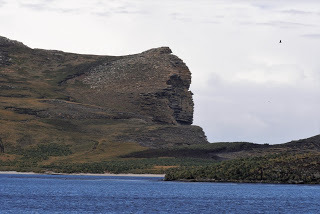 .
. she described her ordeal of living here and the local people. I also had a nice chat with David, the owner of Saunders island, on the beach. We talked about the island and their experiences during the war, which never really came to their side of the islands, although there was a plan by the Argentines to round up and kill all of them, they were ready to at least try to give themselves a sporting chance with the firearms they had at that farms, but suspected they'd end up being bombed. Luckily that never happened. They feel the dispute is far from over.
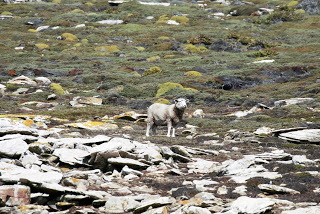
My wife was looking at the "gift shop' the back of a Defender FWD vehicle and this is the last picture picture of her carbon fiber walking stick, she left it leaning against the back of the Land Rover
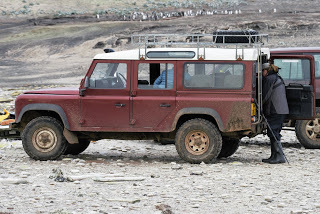
We did buy a nice hat. We were more worried about the wet landing to get back to the ship, in which the waves went over our boots, oh well, at least we got some use out of it
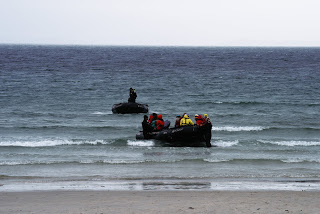 They even rent out this little shack. It is currently rented to four Germans for the week, Oddly, it is booked until 2023. I guess this is a destination. It looks a bit bleak for a destination vacation. Maybe the inside is nicer.
They even rent out this little shack. It is currently rented to four Germans for the week, Oddly, it is booked until 2023. I guess this is a destination. It looks a bit bleak for a destination vacation. Maybe the inside is nicer.
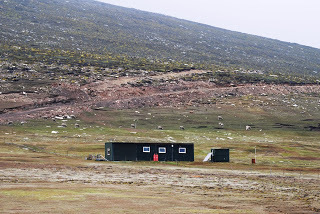
The weather was true Falklands, rain, sun, and wind up to 40 mph, it changed every hour on the hour. It was a place that before this, was only on the map. This wasn't a bucket list item, but seeing penguins were. We saw five species of Penguins.
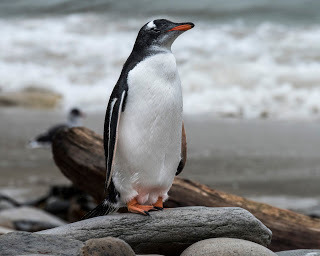 gentoo penguin
gentoo penguin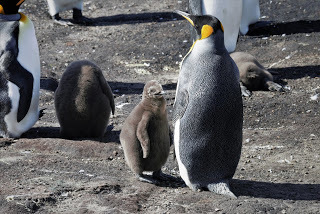 king penguin
king penguin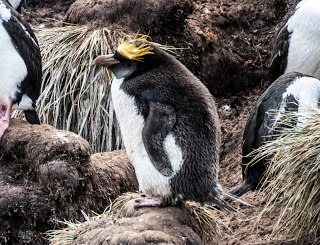 macaroni penguin
macaroni penguin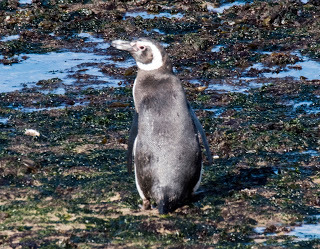 Magellanic penguin
Magellanic penguin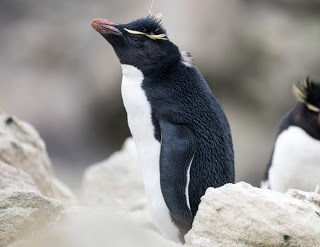 Southern rockhopper penguin
Southern rockhopper penguinThey were all cool birds and we saw their breeding areas, the gentoo chicks were the most active walking up to you and giving you a weird look or they were heading off into the sea
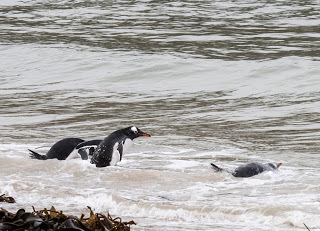
There were some other cool birds around
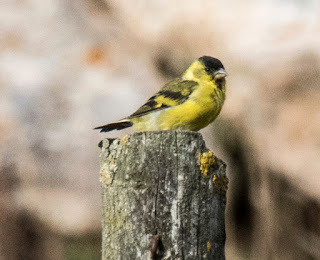 Black chinned siskin, this was the only one seen
Black chinned siskin, this was the only one seen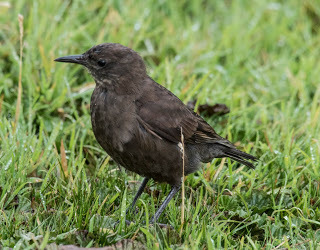 blackish cinclodes (tussuckbird)
blackish cinclodes (tussuckbird)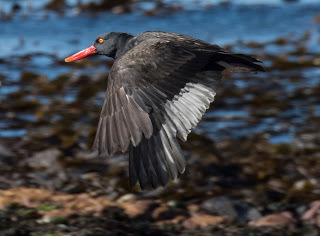 Blackish oystercatcher
Blackish oystercatcher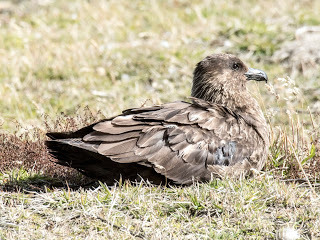 brown skua
brown skua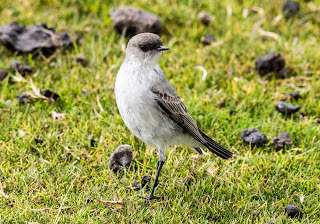 Dark faced ground tyrant which I also saw on the ship, as 3 flew out and cruised around for a couple of days
Dark faced ground tyrant which I also saw on the ship, as 3 flew out and cruised around for a couple of days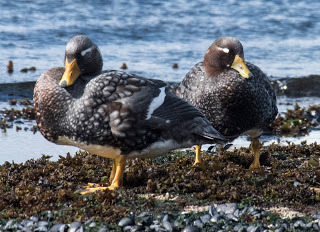 falkland steamer duck, it was cool to see them "steam", as they are flightless and kick up water like steam when they are chasing each other
falkland steamer duck, it was cool to see them "steam", as they are flightless and kick up water like steam when they are chasing each other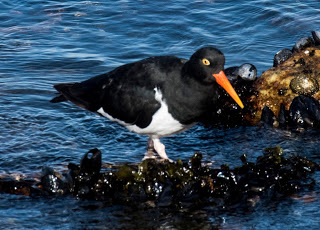 Magellanic oystercatcher
Magellanic oystercatcher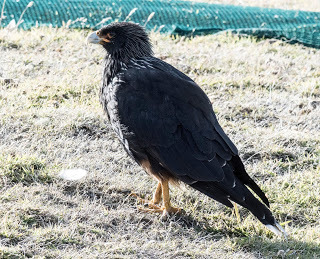 Striated caracara
Striated caracarasadly, we did not go to anyplace that had the endemic Cobb's wren, which is either a species or a subspecies of House wren, but as I said, one cannot get them all and we did pretty good, I'm now at 141 lifer additions, but the question is, how can I drink that much beer? This is a French boat and they mostly have wine but all in all. It was a good visit, save for the walking stick. Some different views with us in them
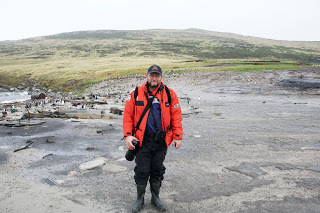
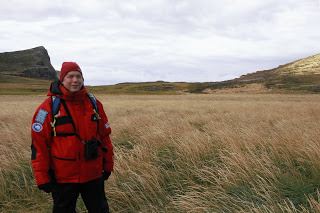
Now it is off to South Georgia, cruising into the high seas of the Roaring 40s, I'll be on point watching for cool seabirds and trying to stay warm exposed on the deck to the cold winds of the south Atlantic. I'll be desiring my own right----identifying the right Giant petrel, are they northern or southern, and the right and correct albatross, Royals or wandering, or the right prion, only God can identify prions and as I said, below 50 there is no God, so I guess even He doesn't know
Cheers, Olaf
Published on March 07, 2019 03:23
March 4, 2019
The End of the Earth
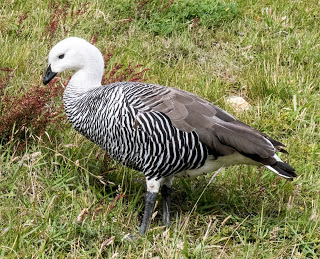 Ushuaia, Argentina
Ushuaia, ArgentinaThis city is the second farthest south inhabited village on the planet Earth, it is called the end of the road as, Argentina Route 3, ends a little west of the city. It was founded in 1884, except that when it was founded, 300 people already lived there as British missionaries had come 15 years earlier. It is hard to know what is anti-British propaganda and what is real in Argentina. The Argentines still claim the Malvinas are theirs despite the fact that they lost a war over them and almost all of the residents of the Falklands voted to stay British. The Argentines claim the vote was rigged and have signs like this on busses, in the airport, on the roads, in the stores, and on the schools
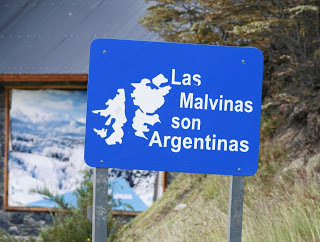 We did not come down here the solve political issues, we came down here to bird and to connect with our trans-Atlantic expedition aboard the LeLyrial, a French ship making an expedition west.
We did not come down here the solve political issues, we came down here to bird and to connect with our trans-Atlantic expedition aboard the LeLyrial, a French ship making an expedition west.It had rained in this southern terminus of America for something like 50 days. It was 48 degrees as it was always 48 degrees here in the summer, before winter comes in a month or so and they get three feet of snow. For us, the weather cleared and it made for great birding. We spent 48 hours searching the few miles of roads and hiking the trails in the park here which at the few vistas was ran over with buses of day trip tourists from cruise ships. We met lots of European youth on Patagonia hikes and camping trips but on the trails we found not a single human. This was great as it didn't take us very long to find one of the most sought after birds in the Americas...the Magellanic woodpecker. In fact, we saw three.

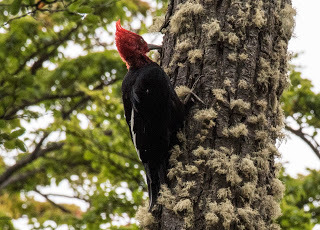 An impressive bird and the single thump of the male on a tree was the loudest thing i'd ever heard.
An impressive bird and the single thump of the male on a tree was the loudest thing i'd ever heard.We then stumbled upon the local hummer, a green-backed firecrown, which when I heard the chirp, made me think, a hummer...here...? But then we finally saw it and got a photo.
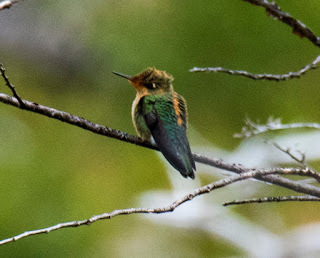 We then made a list, to find, searched for habitat and started ticking birds...
We then made a list, to find, searched for habitat and started ticking birds...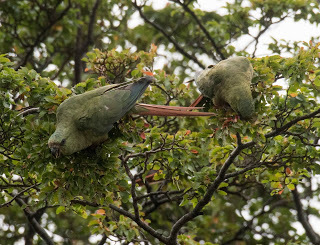 austral parakeets
austral parakeets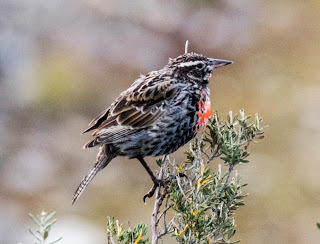 long-tailed meadowlark
long-tailed meadowlark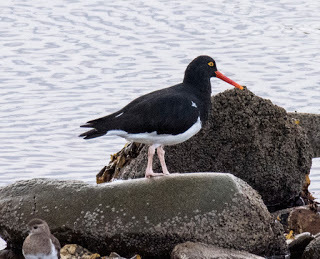 Magellanic oystercatcher
Magellanic oystercatcherI spotted my lifer penguin, a Magellanic penguin
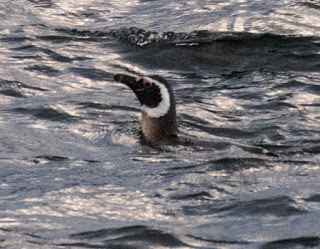
They have cool geese and ducks down here including this strange flightless steamer duck
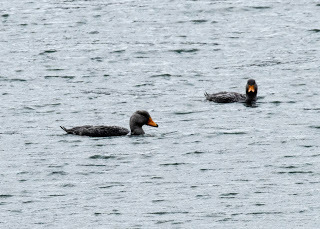
they still have glaciers here...
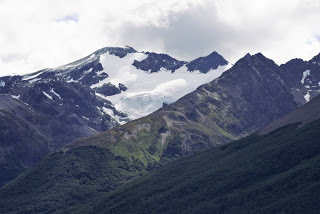
cool cormorants like this imperial cormorant
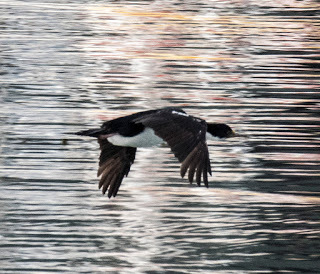
with over thirty lifer birds in 48 hours it was finally time to find our ship, the La Lyrial, for what the captain called an expedition. The captain greeted us by saying...'Below 40 degrees south there is no law; below 50 degrees south there is no God'
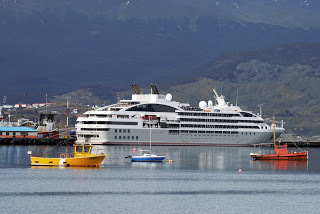 The La Lyrial at port, Ushuaia, March 2, 2019
The La Lyrial at port, Ushuaia, March 2, 2019We would be sailing the Roaring 40s, and as the Bad weather man currently having nice weather, was it the calm before the storm? At least we would eat well, it turned out the captain of our liferaft was the head chef who was introduced as the most important person on a French ship, but who would save the wine? There have been other ships to sail from here, The HMS Beagle twice. When the then 44-year old light cruiser the ARG General Balgrano left port in Ushuaia, Argentina in April 26, 1982, it had already had a long history. The ship formerly known as the USS Pheonix had been at port in Pearl Harbor on December 7, 1941 when the Japanese attacked and it was not hit. It survived the entire war receiving nine battle stars and then in 1948 was sold to the Argentine Navy. On March 3, 2019, our ship the Le Lyrial, entered the Beagle Channel (one of the three passages between the the Atlantic and Pacific Oceans and exited it into the Atlantic ocean just as the Belgrano did bound northeastward towards the Falkland Islands and the start of our expedition and a trans Atlantic croissing. Back in 1982, what happened next will always be under some dispute. The Belgrano stopped south of the Falklands and patrolled with three other ships and was monitored by a British submarine. A few days later, an order was given by the Argentine admiral that the ship would support military action in Falklands which had been invaded a month earlier, and then fearful of this, the British attacked the ship and it was hot by two torpedoes and sunk, just under 300 Argentines died as a result. About half of the casualties of the entire Falklands War. A few months later, the British retook control of the Island group and Argentina left in failure. well, it was good to leave Argentina for us, no matter what happens as our travelling companions, Don and Nancy broke their bathroom, due to a towel drier incident, and it was only a matter of time before our car's brakes failed and we'd roll down a hill into a shop.Even my penguin Leroy after trying to fly in Buenos Aires, and I was just able to catch him in the nick of time...
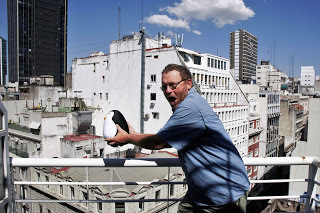 Learned that the local ships had some other issues, he is a troublesome penguin...
Learned that the local ships had some other issues, he is a troublesome penguin...
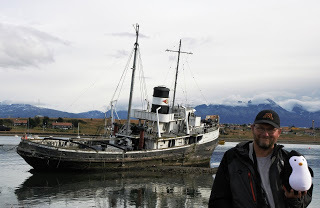 that Leroy....hopefully he'll keep us out of trouble, as he went birding with us the day we got the hard to get woodpeckers so he has been lucky in the field, but he just hikes a little slow.
that Leroy....hopefully he'll keep us out of trouble, as he went birding with us the day we got the hard to get woodpeckers so he has been lucky in the field, but he just hikes a little slow.I hope our ship has a better fate.
Olaf
Published on March 04, 2019 18:54
February 24, 2019
All the screaming and Gathering of Firewood
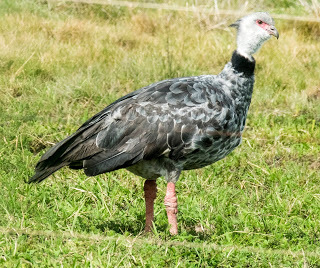
On January 27, 2013, the black-bellied whistling duck became the number one bird on my life list, as I flushed a flock in Santa Ana NWR (Texas). It was the top bird as it was the top bird in taxonomic order. It replaced a Fulvous whistling duck I had seen 49 days earlier in Florida. This duck began my list every time I looked at it for a total of 2218 straight days until yesterday.
We were driving to a place called Laguna Rocha and the ladies needed to find a bush as we were out on a dirt road about 60 miles west of Brazil and both bushes and bathrooms were in short supply. I scanned a field and out there was this huge bird, I had no idea what it was and then, there was another in the pasture on the other side. It was kind of a big and ugly bird and then I looked it up. The name-- southern screamer jumped out at me as an odd name and then it saw me, and I learned why it had earned its name. It sounds like a goose got stepped on by a very large foot. I took pictures and I added it to my list and guess what, this species comes before waterfowl. The event made me smile. It is an event that no one cares about including most birders but there I was, with a new leading bird.
Southern screamer is a name that would be better put to be the title of a Faulkner novel. It would be about some terrible Mississippi family that killed college students at Oxford area near where Faulkner taught....or it could be a bird in South America....
There are lots of birds down here with very cool or odd names. The screamer is great but what about the FIREWOOD GATHERER? Don't you picture and even bigger, more fierce looking bird?
In reality....
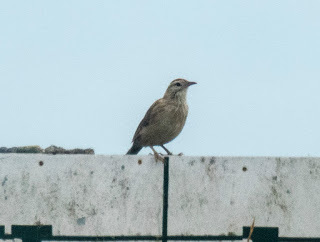 Kind of an unimpressive bird with a big sounding name, firewood gatherer, it looks like a small meadowlark
Kind of an unimpressive bird with a big sounding name, firewood gatherer, it looks like a small meadowlarkThen we got the wren-like rushbird, this acts like a very shy marsh wren, sounds like a rail, and it was an act of courage from snake attacks to even get this one out
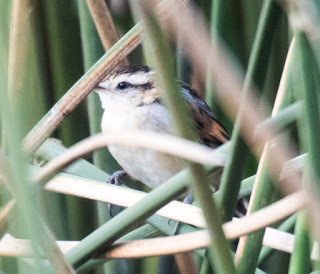
All and all, despite the new language and names, we've been behaving ourselves. After getting in the middle of a TV episode, and then today getting in the middle of a fashion shoot at a arboretum, we even photographed a streaked flycatcher, well I did as my other two photographers were setting up their tripods as the bird flew back into the tree deep in cover.
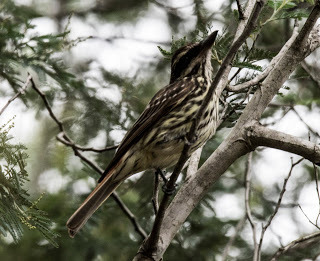
As we watched (again the ladies were in the bathroom), the fashion photographer photoed pretty girls in a doorway with revealing clothing. We were standing 20 feet away. The ladies changed behind a bush, and had on nothing else underneath. Leave men alone and stuff like this happens. When Don Harrington suggested if he could photo the ladies with his large 600 mm lens on a tripod, using hand motions, they shook their heads and everybody went to shoot at another location, quite quickly I may add."Just asking." he said to me, but we got two birds there so all was well. Uruguay has some of the worst marked roads anywhere and in Punta del Este even with Siri, we got really lost. It kept wanting to take us back to where we started, and then today, while in a small park, maybe 500 acres with a hotel in the middle and with a map, we ended up lost and going the wrong way on one way roads and on roads that were only for pedestrians. We came up to find rheas, but I was following an ebird post that was an errant or miss entered post, we could not find any open ground, unless we could find the top of a tree and scan the horizons. Don was using his translator program to translate, "help, I'm held captive against my will." He kept threatening to play it to anyone passing by or standing outside, luckily, the program uses a different dialect of Spanish. It was a waste of a day so I amused myself looking at bees and rhinoceros beetles
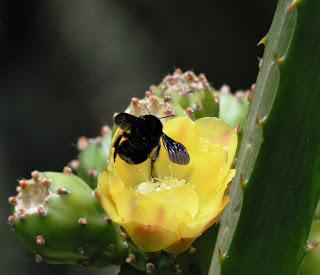
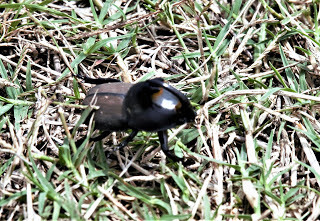
Then dejected, I drove us all home. Somewhere south of where there had ever been any ebird posts for rheas my wife in the back seat yelled, "stop! BACK UP! Olaf's side." I'm perplexed as to what she had seen. I asked but she couldn't spit it out. The last cry for stop was for a house cat. She is keeping a mammal list to spite us. we'd already had a sheep call so I was hesitating. But then, I could not believe my eyes, right next to the road was a flock of greater rhea.
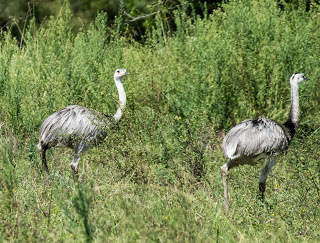
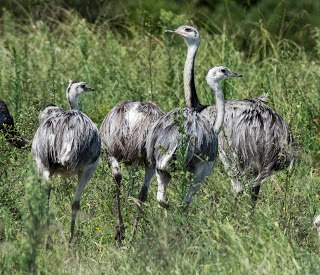 My heart nearly stopped, as we had given up on this bird, my wife got a kudos, a big kudos, we got the bird and she saved the day. The getting lost and the 100 mile wild rhea chase was now forgotten.I looked to the other side and got a bonus bird...
My heart nearly stopped, as we had given up on this bird, my wife got a kudos, a big kudos, we got the bird and she saved the day. The getting lost and the 100 mile wild rhea chase was now forgotten.I looked to the other side and got a bonus bird...
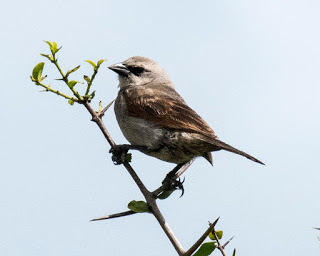 a grayish baywing on a weed, you got to like two-fer stops and bonus birds.
a grayish baywing on a weed, you got to like two-fer stops and bonus birds. The rheas ran off after everyone got photos, well my wife doesn't carry a camera but the Harringtons and I did. Then I entered the birds to my list, the greater rhea jumps to first on my list, sorry screamer, your stint on the top...only for one single day is over. We'll see if I can get something higher on this trip, but as only two species higher, both types of ostrich, it won't happen tomorrow, that I can guarantee. Besides trouble finding lunch stops, we've had a marvelous bbq, and good food. It is very safe here despite the unmarked roads, as luckily the traffic is light. Like everywhere, guys on motorcycles yell things at us as we look funny to people, what sane person birds? It cooled off today, so no more 90s, just 70s, and in three days as we begin our journey into Argentina, its going to get colder, much colder. We have seen a slew of good and new birds, exciting and beautiful birds and enjoyed a wonderful country, one few from the US ever get to see. It is rolling hills and mixed fields and scrub.
Here are a few of the last two days birds:
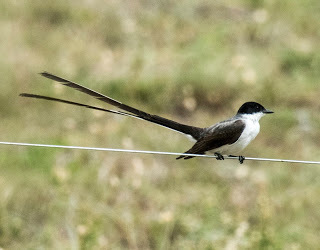 fork-tailed flycatcher, showy here or at home somewhere as a vagrant
fork-tailed flycatcher, showy here or at home somewhere as a vagrant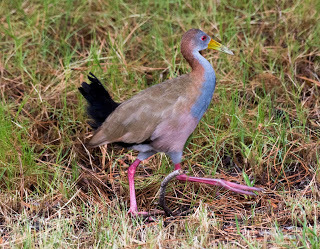 giant wood-rail, these things....I almost hit one with a car today
giant wood-rail, these things....I almost hit one with a car today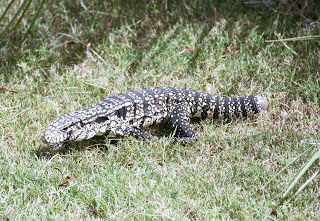 More giant things...the Giant Tegu lizard, which can be house broken, they say, I wasn't inviting this one in to find out
More giant things...the Giant Tegu lizard, which can be house broken, they say, I wasn't inviting this one in to find out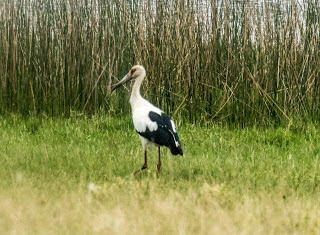 Maguari stork, which most closely related to the white storks of Europe, ones in cartoons and seen by me on roof tops in Germany. Their common ancestor was a now extinct stork from North America they say that got a round during the ice age and then led to these two species
Maguari stork, which most closely related to the white storks of Europe, ones in cartoons and seen by me on roof tops in Germany. Their common ancestor was a now extinct stork from North America they say that got a round during the ice age and then led to these two species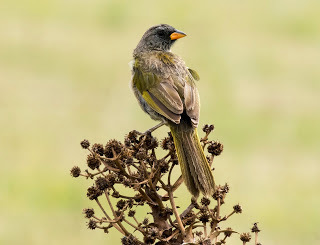 great Pampa finch
great Pampa finch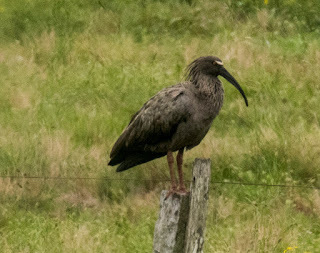 plumbeous ibis, what a mean looking ibis
plumbeous ibis, what a mean looking ibis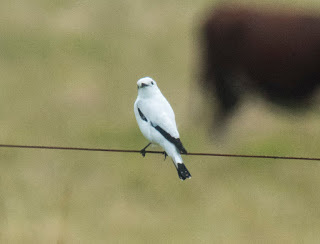 white monjica, how is that coloring help with anything besides breeding?
white monjica, how is that coloring help with anything besides breeding?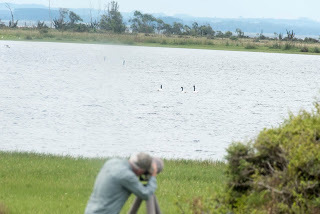 Don taking photos of black-necked swans
Don taking photos of black-necked swans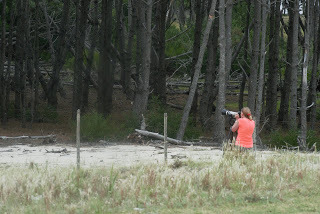 Nancy taking a photo of white monjita in a tree
Nancy taking a photo of white monjita in a tree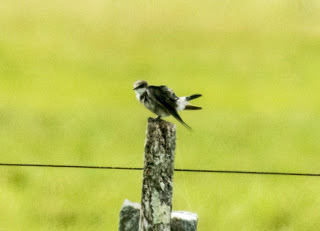 I take a random shot at a swallow to test the focus and it is a white rumped swallow, a lifer bird
I take a random shot at a swallow to test the focus and it is a white rumped swallow, a lifer bird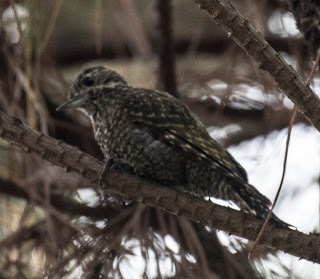 white spotted woodpecker in almost no light
white spotted woodpecker in almost no lightWe've found a great place, but our time here is running short, tomorrow a last big push birding and then we go to Montevideo, a town I've always wanted to see, and then we take a ship across the River Platte to Argentina. More as I see fit to post it. got a lot of birds and great stories and to be honest, we haven't really got anywhere "great" yet, as who would have visiting Uruguay on a bucket list for 35 years?
Only Olaf
I'm off to gather firewood for a BBQ, I here some birds around here can help and then I need to scream for some matches...or something like that
Cheers!
.
Published on February 24, 2019 18:06
February 22, 2019
On the trail of Charles Darwin
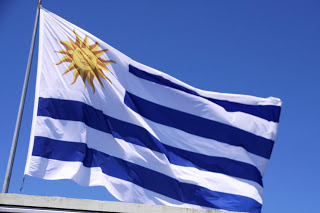
When Juan Diaz de Solis landed in Punta del Este in Uruguay in 1516, he was immediately killed and eaten by the local indigenous people. Now 503 years later, when Olaf landed at the same spot, all he did was get some sun and find birds.

In 1833 aboard the HMS Beagle, Charles Darwin came ashore at the very same beach we are staying at to have a bath. Like us, he was taking a break before heading still farther south to log wildlife and try to prove his budding theories of evolution. We are following many intrepid explorers, Darwin, Shackleton, Charcot, and even Diaz, but we don't expect to be the fare of the day. Darwin came to bathe here and so must we.
Uruguay is a marvelous place. It is unlike any place I've been and was a fitting number to tick off my bucket list. Birds....we are staying in a place named after a diminutive dog, Chihuahua, and it is birdy as heck, and so far, we are figuring out what is what and I'm already over 35 on my life list and we haven't worked that hard. It is hot, it is clear and the sun on the flag calls us, and even yesterday after some good birds, we went to a vineyard for lunch and wondered in the middle of a Discovery Channel "Charlie Wine" episode.
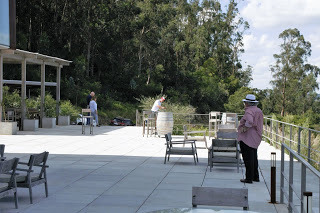
here he is waiting on his production manager to set the scene. On camera, Charlie came over and gave us some fresh pressed chardonnay juice. It was so good. All the while we ate the most marvelous lunch in a long time. The only reason we got the reservation was because it was being filmed. The view was stunning, too.

The star and the host drank wine since seven in the morning, and arrived to the winery in style. Olaf can only admire the old Chrysler Imperial convertible
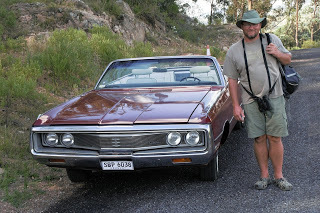 .
.It was to my advantage to drive home as the sober designated driver as no one complained when we stopped for a bird. We took off after shaking the wine personality's hand from Miami, and started to bird. The first stop home was a two-fer
 brown and yellow marshbird
brown and yellow marshbird
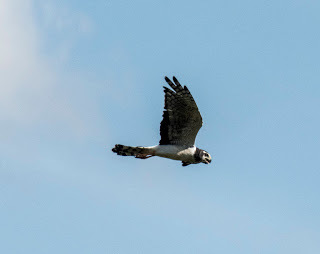 long-winged harrier
long-winged harrierwe've had a cornucopia of good food and birds...
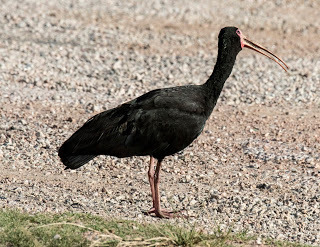 bare- faced ibis
bare- faced ibis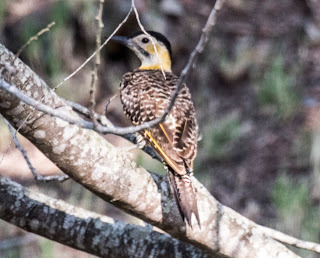 campo flicker
campo flicker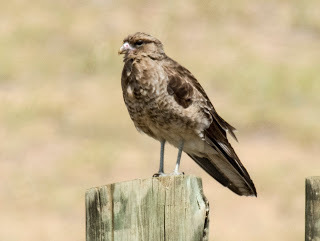 chimango caracara
chimango caracara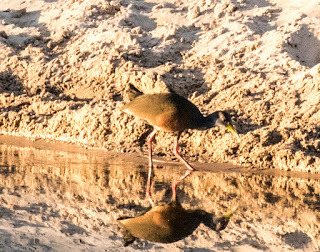 grey cowled wood-rails
grey cowled wood-rails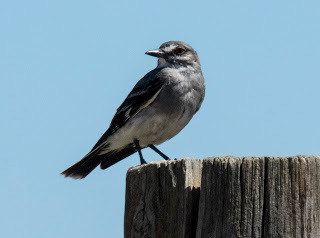 Gray monjita
Gray monjita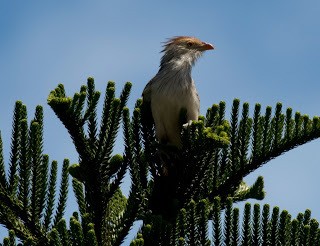 guira cuckoo
guira cuckoo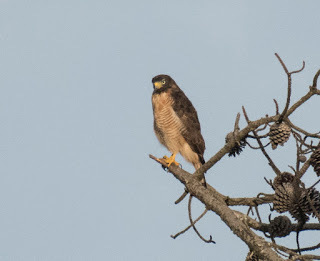 roadside hawk
roadside hawk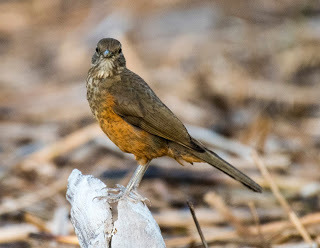 rufous bellied thrush
rufous bellied thrush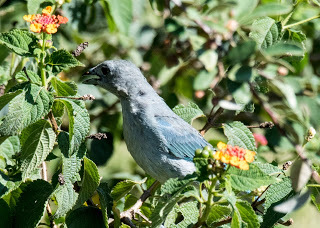 sayama tanager
sayama tanager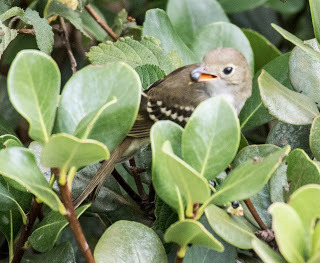 short-billed eleania
short-billed eleania
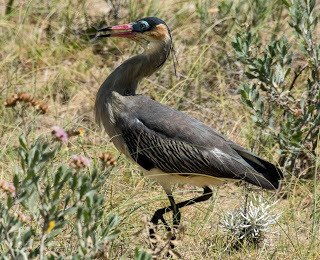 whistling heron
whistling heron white banded mockingbird
white banded mockingbird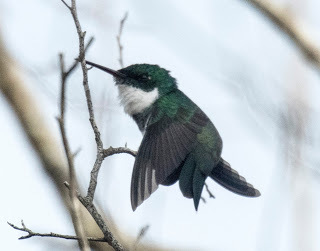 white throated hummingbird
white throated hummingbird
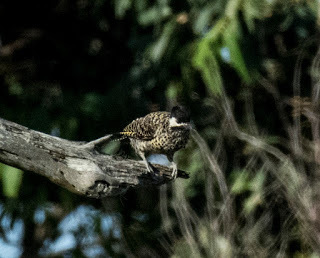 green barred woodpecker
green barred woodpecker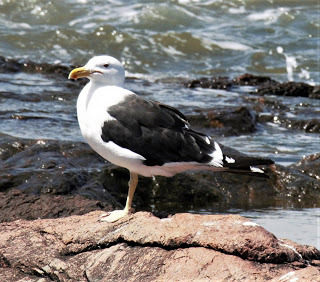 kelp gull
kelp gull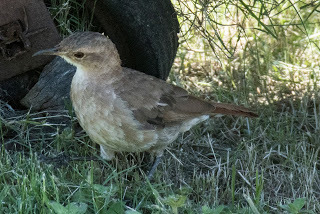 rufous hornero
rufous horneroThis is just a start. Cripes I even got to see monk parakeets in their native environment
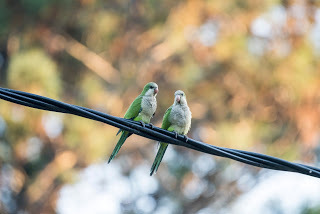
So here I am 80 degrees latitude south of home, I'm exactly at 35 degrees south. I'm taking a bath like Darwin, logging birds and waiting for the next leg of the adventure and honestly coming here is a trip of a lifetime. Safe, warm, not crowded, and full of birds.....
I'm plus 36 on lifer birds, and I have birds yet to be identified, so all is good, and last night I had Harris hawks outside my door and the night before that, fork-tailed flycatchers, all birds I don't need.
Till the next report, I'll try to stay off the TV, next time
Olaf
Published on February 22, 2019 11:11
February 18, 2019
The great journey begins…

TRAVELING, IT is said, can be the best of times, and it can be the worst of times. As we boarded the first leg of our flight to Montevideo, Uruguay, a two hour flight to Atlanta, and settled in a first class row, two, for us, it was the best of times. For our travel companions, Don and Nancy Harrington, now of Gary, SD, previously of Northfield, Minnesota, it was the worst of times. They had booked their flight in two pieces, one on Delta and one on Travelocity, and as the computer showed they were stopping in Rio (even though in reality only to catch a connection), it demanded a visa, This despite Brazil not requiring a visa for transit stops, but two reservations, meant a computer flag. Brazil only started requiring visas when we started requiring visas from their travelers around the Rio Olympics. Delta would not let them get a boarding pass. I joked to a Delta representative on my side of security. “Nothing a credit card wouldn’t solve.” Unfortunately, it looked as though it would take many thousands to solve it. Luckily, with all my big year travels, and open ended tickets, I consider myself a very wily traveler. Delta and all the Canadian airlines gave me grief in arriving into Canada with open ended return tickets, once I even was forced into the inner sanctums of immigration, but I talked my way out of it. I’m certain, I could have talked my way out of this, but…I wasn't there and as, for us, I had really nice seats, I texted, we will pick you up in Montivideo airport whenever you get there. We had slush on the first week of our schedule. They'd catch up. We landed in Atlanta and then got a text from them back in Minneapolis, they had boarded. It turns out they weren't even on our flight, and we'd met up with them in Atlanta, they were a little poorer and well, we all had a laugh. I'm sure it wouldn't be the first fiasco of this 21,000 mile trip. We were circling the Atlantic Ocean and the first stop, would be Punte Este, located in Uruguay, a place to tick a bucket list "Visit Uruguay." I'd have a lot of bucket list items and I had some serious goal birds, one of which the Wilkin's finch had only been logged on four eBird checklists, some others, Tristan thrush, Gough moorhen, just to name a few would be marvelous birds, but tomorrow I hoped at least to tick a kelp gull, I'd be happy to start with that. It turns out we had to part ways again as they were heading to Sao Paulo and us, Rio before we landed within a few minutes in Montevideo, oh well, they can find me at the Alamo counter. It was a long trip, Leroy (above) is not a heavy drinker so he could only get a single celebratory campaign, the stewardess asked me what the penguin wanted and I paused, what does a stuffed penguin drink? All for now, day one is almost over and we have a really long 9 hour flight below the equator, my first time this far south.
Cheers
Olaf
Published on February 18, 2019 16:41
February 11, 2019
Leroy, on the Rio Grande
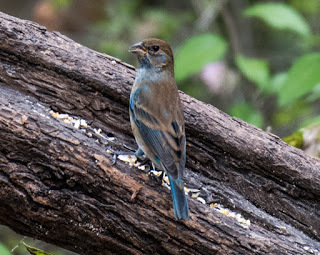 YET ANOTHER BLIZZARD was inbound on the 5th, after a day at home to regroup and repack from my cruise. I arrived home during the Super Bowl, sat down with my wife and watched New England win yet again, and passed out from exhaustion. 6400 miles by car, plane, and boat will do that to a person. Now at 2 AM we had to get out and drive down the road to the airport, 224 miles away and catch a flight to Texas. The LRGV, Lower Rio Grande Valley, the mecca of winter Texas birding and, a place for warm recreation. It was a trip with both Silja, and my traveling bird buddy (not to be confused with traveling birder buddy), Leroy. It would be Leroy’s first trip to Texas. It takes a brave guy to travel with a stuffed penguin but what the heck. He is a familiar face, and anything familiar is good when traveling.
YET ANOTHER BLIZZARD was inbound on the 5th, after a day at home to regroup and repack from my cruise. I arrived home during the Super Bowl, sat down with my wife and watched New England win yet again, and passed out from exhaustion. 6400 miles by car, plane, and boat will do that to a person. Now at 2 AM we had to get out and drive down the road to the airport, 224 miles away and catch a flight to Texas. The LRGV, Lower Rio Grande Valley, the mecca of winter Texas birding and, a place for warm recreation. It was a trip with both Silja, and my traveling bird buddy (not to be confused with traveling birder buddy), Leroy. It would be Leroy’s first trip to Texas. It takes a brave guy to travel with a stuffed penguin but what the heck. He is a familiar face, and anything familiar is good when traveling.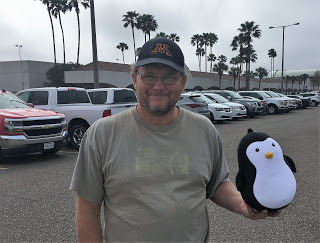 Leroy, the birding penguin, Valley International Airport, Harlingen, TX
Leroy, the birding penguin, Valley International Airport, Harlingen, TXI skipped a report about Roatan, as I've written about that twice before. I did see some good birds and had a great albeit brief visit.
 Canivet's emerald, Roatan, Honduras
Canivet's emerald, Roatan, HondurasI skipped my adventure a week ago on Cozumel, because I don't really like Cozumel
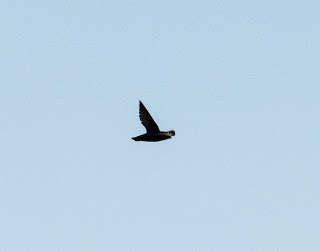 Vaux's swift, Cozumel
Vaux's swift, CozumelSo I'll just discuss the trip I just returned from the Lower Rio Grande ValleyI hadn’t been down here since I chased a crow down here with my son fourteen months earlier. This would be a different sort of trip, one in which the primary goal was rest and warmth, and birding would be secondary, well, secondary for me seems intense to some people. We would also avoid the Brownsville dump.The weather was nice and well, it was nice enjoying the weather for a change. The next morning, we woke up early and decided to head to the border to find a bird before they built the wall there. The area near Bentsen State Park was earmarked for a border wall, and the construction would undoubtedly affect two hook-billed kites hanging around. It is hard to think about what to expect for this project and it is beyond the scope of this blog. We walked up on a dike and looked for the kite. The first thing we saw was markers for the wall (seen below).
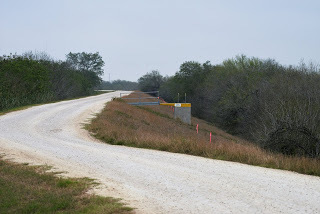
I'm not a big fan of this wall, at least here, and I've pointed out places, it sure seems a glaring omission in the landscape as I've pointed out before (Jacumba California, Montezuma Pass AZ). You can blame the Republicans but to be fair, Obama never passed an immigration reform policy even when he had both houses and a super-majority of the Senate. This is a national problem despite what the left says and the problem is not exactly what the right describes it as either. It is simply unskilled immigrants taking jobs from unskilled and poor US citizens or legal immigrants. It is simple math to many businesses, it is much cheaper and simpler to hire every illegal one can, and this is to the detriment of most of our minorities, be it Hispanic, African-American or wherever. You see it at the meat packing plants in the Midwest, farm labor, construction, and nursing homes to name just a few. I always find it odd that those here legally, the unions, and the NAACP don’t speak up, all Democratic supporters. These people are being jumped in line for services and jobs by non-citizens. It is all a drive for cheap food, cheap goods, cheap everything. I guess nobody cares, they just want to believe what they are told. We walked around a bit, I ran into a birder I knew, Christian from San Antonio, and then as we walked a little east, the kite was spotted in a tree.
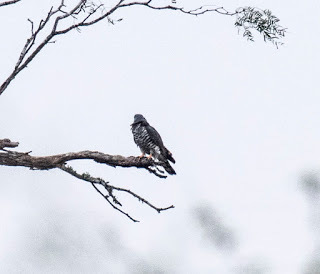
I will say, thinking about it and after seeing the kite, the wall will not do much good for birders, that is all I got to say. Before you fellow bird chasers start having a cow, understand that many of the same people fighting the wall, want this “Green Manifesto” implemented which also calls for the end air travel in 10 years. That means no bird chasing, no flights to Alaska, and also, no flights down here. You can’t get to McAllen on a train. In a nutshell, we are all HYPOCRITES. We think green, we want to save this, and yet how much gas and air fuel do we burn. I know of one man who biked around the country looking for birds during the year and even in his case, he had some gas powered support. Where we saw it, the bird would be obscured by the birder wall, so in this case the wall would not be a very good thing at all. Finding the bird was good news. Oddly there were as many reporters around as birders, and at nearby Bentsen State Park, they also had a bike outing for senior citizens. Only four of us saw the kite. I’m not sure where the state park that sits on the border will figure into all of this. I just wish there was another way. The entire country of Honduras except those on Roatan and in the government seems to want to come into America, and those that remain seem to want them to go. Again, I’m just a birder, so these are above my pay grade. I vote in South Dakota, the last primary, so we won’t matter much. All I know is places like Matamoros, and Reynosa, Mexico, places that used to be tourist friendly, across the border, are now some of the most dangerous places in North America, murders in Reynosa quadrupled from 2015 to 2017. The US warns people to avoid travel in this region. The locals say it is still safe to walk over to Nuevo Progreso as long as they stay on the main street, but going there doesn't excite me.
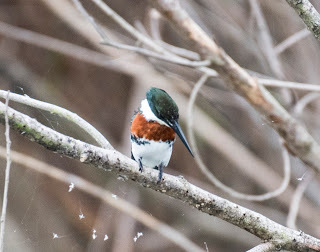 green kingfisher
green kingfisherThe bad thing that happened was that my wife’s back tightened up, and so after a little while staking out a feeder in McAllen and dipping on a crimson-collared grosbeak, we had to go back and get some sun. We’d have one more nice day before things would cool down. The warmest two days I’d have during this whole tropical swing would be here in South Texas.The weather forecaster the day before warned that the weather would turn at five in the afternoon on the 7th, and after a lazy day at the pool, hoping my wife’s back would heal, at precisely five, while we were having a cocktail, telling stories, the front came through. Before that as the wind had shifted, the hawks came out and hovered over the resort, and sat almost motionless. These were mostly Harris’s hawks, all dark resembling stationary vultures except for the white visible occasionally on the top of their rumps. A solitary smaller gray hawk flew over higher being pushed southwards. A lone purple martin was flying around before it got blown out of the area. They know me where we stayed. I’m a bit of a celebrity here. I signed books and got invited over for beer and cocktails. As the wind had picked up and there was nothing left to do except socialize so we went out with resident birders, Sandi and David Junkin, the discoverer of the Junkin warbler, an odd hybrid he documented. It was a nice dinner of “fresh” octopus, although the theory of ‘fresh” octopus in south Texas made me laugh. Somebody at the dinner joked, that they must swim up the river here.The weather went shockingly colder the next day, bottoming out at 39 degrees 36 hours later, a 51 degree drop. It was almost too cold to bird but I did go over to a place called Quinta Mazatlán and work on a bit of a troublesome bird for me. I saw a crimson-collared grosbeak twice during my big year, but neither episodes were good views and neither allowed me a photograph, once due to rain (wasn't going to ruin my camera for a bird), and the other, it was deep in scrub and appeared too close to me and I couldn’t find it. I’ve also dipped twice in this bird, earlier, the first in 2014.Two days earlier, I not only dipped on this bird, but the stakeout caused my wife’s back to stiffen up, so I made this visit alone. At noon, I was getting cold, damp and the bird had not been seen. A rather pugnacious marauding young Cooper’s hawk made a pass through the feeder and then rested at the feeder.
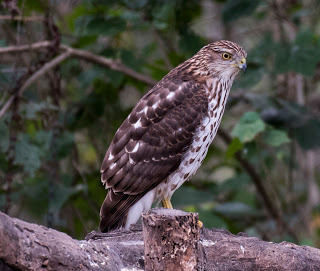
It didn’t lead well to seeing anything since going to the feeder put a bird’s life in danger. Suddenly, a man walked in behind me. “..you need the grosbeak?” I followed him and looked in a bush, and then it appeared in the open for an instant. I got a good look and then as I raised my camera and it was gone. This Mexican bird is one I doubt I’ll ever photograph, oh well. I’ve now seen it three times and that is better than many. I can’t photograph them all. What to do on a cold day in South Texas? We headed over to Bass Pro to buy gear for Patagonia. It was a lot warmer than birding. The car thermometer stated 43, it was too cold for Texas on the Rio Grande, it might have even been too cold for Leroy, except I guess, if Leroy was alive, he’d be a penguin and 43 would be a nice day for him, and it would probably be what we’d see in South America, when we find Leroy’s cousins.We moved resorts for our last day and we did this via Estero Llano Grande State Park. We were going to go the Valley Nature Center as they had apparently now had the golden-crowned warbler, but it didn’t open until noon on Sunday, so another bird I didn’t need, we went to Estero. We walked around the park and saw 37 species in the park before stopping at Stripes for another great egg burrito. I just love those things.
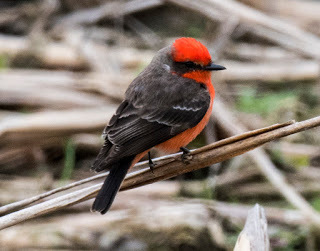 Vermilion flycatcher, my wife's favorite bird
Vermilion flycatcher, my wife's favorite bird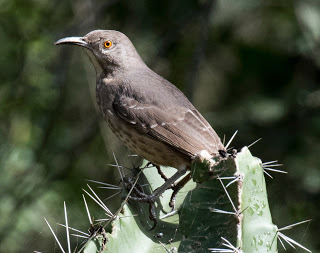 Curve-billed thrasher
Curve-billed thrasher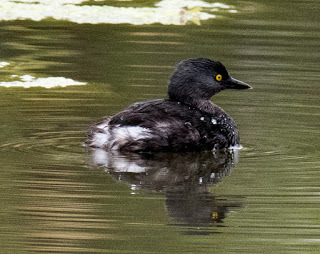 Least grebe
Least grebeI got a life bird at the LRGV but I didn’t actually see the bird, when I was here, well, not this time, but I saw that Mexican duck was on my checklist as an option when I was putting in a checklist for Estero. I didn’t see one then, but back in both 2016 in Arizona, and, here actually, back in January 2013, my friend Jim Brown (“Arvid”) looked up as a Mallard flew overhead and said, that is a Mexican subspecies. I had seen it too and it had the characteristic field marks. After research, I found out it got split in August 2018. I hadn’t got the memo, and didn’t notice that, so, in effect, my Mr. 800 was not the gray heron, it was probably a duck I had seen almost 6 years earlier. I hadn’t realized it then, but I did now, and so, it would forever be life bird #802. One of my screwiest bird additions to my list. All the checklist additions in 2018 were screwy. It is what happens when the checklist changes while I’m fishing off the grid in CanadaMy wife had some obvious thoughts on listers like me, her husband. She thinks that birds that don’t breed in the US or actively migrating should not count. She thinks it’s silly that people line up at the border like here, as well as in Arizona, Florida, etc., and wait for something odd to cross. Vagrants should not be counted. I told her the story of the guy who saw the Amazon kingfisher in Laredo, but while it was in Mexico (the border is almost or, in some cases is on the US side of the river there) and not be able to count it, while I saw it 200 yards away perched on a shopping cart and could.
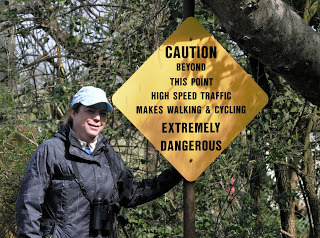
She thinks this would force people to actually go into NE Mexico and bird. They’d have to find the crimson-collared grosbeak there. Maybe such activity would expose the plight of the birds down there and open birder’s eyes to what is happening to their habitat, as well as force the Mexican and the US police to possibly clean up the drug and illegal border traffic. She thinks all lists should be international, too. My wife is a visionary.We were scouting for RV destinations and we visited people we knew from Wisconsin, Helga and Jim, and got some sun, and went to bed after watching a rerun of Columbo. During this trip we visited with many people I knew. I woke up early for a last bit of birding. Where we stayed, has the plain chachalaca at the edge of the property. I’d seen them on a previous trip. This is a cool bird that looks like a roadrunner mated with a pheasant, and then watched movies about chickens all day. It has a really cool name to say…chachalaca! I can say it all day, just like I can eat burritos from Stripes all day. It was a terrible morning to bird—damp, cool, foggy, and it had just rained. I started walking. The locals were wearing down jackets, even the French Canadians were looking cold. It took a while but eventually, two of the silly birds perched on the gray metal fence and looked at me. I said out loud. “Chachalaca!” It was like the end of the movie. I smiled and went in for a shower.Like something you should say in the middle of a game….“Chachalaca!”
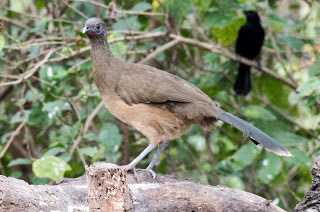 Plain chachalaca, Quinta Mazatlán, McAllen Texas
Plain chachalaca, Quinta Mazatlán, McAllen Texas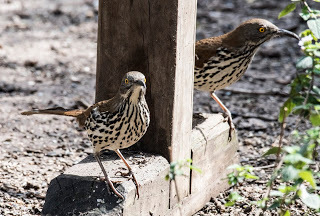 Long-billed thrasher, LRGV Texas So that ended the birding in south Texas. We didn’t push it too hard, with my wife’s injury. All in all, it was a pretty tame adventure with the most adventurous episode being me eating octopus. We needed to get home, (yet another blizzard) drive through the snow, it was really bad driving home tonight in white-out conditions from heavy snow, and pack our gear for the monumental journey. The Grand Voyage awaited us, and we depart in exactly one week. For now, I was done birding the tropics. What was on deck was the unknown, and all great journeys, in my opinion head into the great unknown. Three continents awaited us. Things were moving along, and now we could find out how insane I could really become.“Chachalaca!”
Long-billed thrasher, LRGV Texas So that ended the birding in south Texas. We didn’t push it too hard, with my wife’s injury. All in all, it was a pretty tame adventure with the most adventurous episode being me eating octopus. We needed to get home, (yet another blizzard) drive through the snow, it was really bad driving home tonight in white-out conditions from heavy snow, and pack our gear for the monumental journey. The Grand Voyage awaited us, and we depart in exactly one week. For now, I was done birding the tropics. What was on deck was the unknown, and all great journeys, in my opinion head into the great unknown. Three continents awaited us. Things were moving along, and now we could find out how insane I could really become.“Chachalaca!”
Published on February 11, 2019 20:27
February 4, 2019
Operation: Jamaica
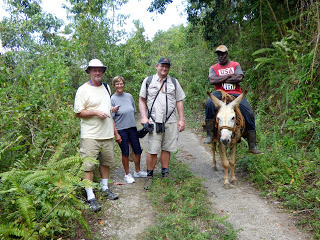
A GOOD Majority of people who visit Jamaica arrive, get transferred to hotels like Sandals, Beaches, or even Hedonism, and never leave the property. They have locals cater to their every whim, all the time surrounded by armed guards, never to leave the gates of their all-inclusive hotels and learn what really is going on or even eat any local food. That is not for me. I go to the road less traveled, or at least a road only traveled by donkeys hauling out the corn while slash and burned areas are still smoldering, a new half acre of destroyed habitat formed for, in some cases, no real reason, or to grow what looks like really sad looking corn. The corn sold for 300 Jamaican dollars per large bag OR $2.25. The cost of a Red-stripe, that donkey will carry two bags back to the village when loaded.
IT HAS BEEN very hard for me to know what to say and exactly how to handle this blog post. One of the reasons was clearly the lack of bandwidth I had last week after I spent the day on Jamaica. The other is the best way to highlight the plight of a woman I met on Jamaica. Her name is Wendy Lee. As I will discuss, she is forced to live a low-key existence, both by the very nature of what she is doing, and also due to where she lives. It is clear that making the average person mad at you in Jamaica could be dangerous. Part of me thinks I should be quiet but part of me says I should shed a little light on the important role she is doing so that maybe, just maybe, a few of us could throw her a bone.
I Know I'm one for hyperbole. I'm one to accentuate the obvious, but in all honesty, if works on Earth can get you a better lot in either the afterlife or in the next life, Wendy Lee would be a couple steps ahead of many of us. In Swedish and Midwestern culture, calling attention to oneself is frowned upon. I've decided to not put her picture in here. She is taking the one above with my two friends and a passing local farmer. Vivian from Ohio, and Stuart from Florida. They are both non-birders but decided to explore for the day.
I landed in Jamaica for a single day last week, having never been, the list of nearly 30 endemic birds on the island plus some from the larger islands I've also never been to meant that I needed some help birding and had much to find. Time was short, though and also due to the dangers of an island such as this, I felt it best to hire a guide. I picked Wendy Lee from west of Ocho Rios by dumb luck. We met up in the morning at her place, and then took off birding.
Beforehand, we were taken around her property which has become a rehab center for illegal, unwanted, and injured birds. I didn't count all the parrots she had, some endemic black-bills, and other exotic species. The local authorities contact her about a mistreated or illegal bird and she picks them up. The only problem is once she has them, the government makes it illegal for her to release them or even farm them out to other caring individuals. As such, her flock grows weekly, parrots live for ever, or so it seems, some of her birds are almost as old as me, and well, there is no end. There is no break in sight for her and what is the end game? She can't carry on this forever.
This is a labor of love, as she is currently without help, a local woman who has helped her wants to retire (or has). There is Little money to pay anyone or even buy food for her birds. The birds and her really need your help, but I'm not sure of the best way...
Wendy can be best described as a bit of a burned out environmentalist, a person who practices what she teaches, and I don't say that disparagingly. I'd have gone postal long ago if I'd been her. She has spent much of her life trying to teach the local population that there is a better way than just throwing their garbage everywhere, she also tried to point out to the government that slash and burn was a bad plan, but all she has seen in the last twenty years is a growing problem, made worse every year by human and government indifference.
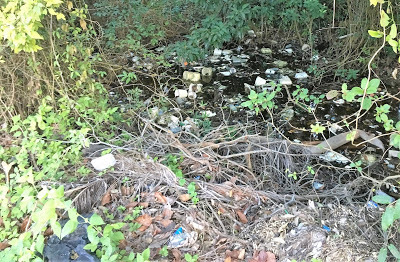 Don't let me get started on Cozumel, they have an even bigger garbage problem. Here is a soup of garbage just a few hundred feet from the busy tourist port, yet ignored by millions of tourists
Don't let me get started on Cozumel, they have an even bigger garbage problem. Here is a soup of garbage just a few hundred feet from the busy tourist port, yet ignored by millions of touristsThere is the old argument of trying to teach poor people environmentalism when they are just trying to feed themselves, but that is a "cop-out."
This brings me to the Dutch kid, Boyan Slat. The kid who has people give him hundreds of millions to build some new age plastic collector that will magically strain the ocean of plastics. All well and good, except it hasn't worked yet. This is like a huge super -super computer to improve the education of our kids. The problem is local. We need to forbid the manufacturing of plastic bottles. Place a huge deposit on them, and find something to do with the plastic. We all recycle, seems good, and honorable, but most of that plastic has ended up in China and I've read, has ended up in the sea anyhow.
Plastic is a local problem. Instead, take twenty million, go to the poorest areas of Jamaica, pay them say, $100 per pickup load of garbage, burn it in an incinerator until its all gone. You've motivated the poor, you clean up the crap, take another 40 million and do the same thing in Mexico, Bangladesh, and some other countries...all the while banning the stuff. we got plastic because of environmental concerns over cutting trees for paper and paper containers, laziness over cleaning returnable bottles, and because it is cheap and easy. We are all to blame. My water bottle is aluminum, I drink my cola from aluminum cans, what do you use?
Anyhow, my plan will (which is not really my plan, others say the same thing) will rid the world of plastic better than Boyan's great contraption, but helping out a young guy is so cool...
enough rant....
Wendy took us birding, me, and two non-birder, Stuart and Vivian, up into the mountains and we saw some cool things. I saw 18 lifer birds, photographed a northern potoo, and I even got to hear the cool call of the Blue Mountain vireo
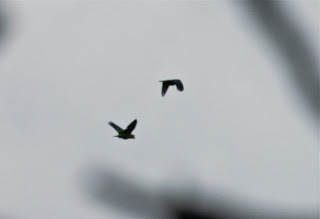 not the best photo of a black billed parrot
not the best photo of a black billed parrot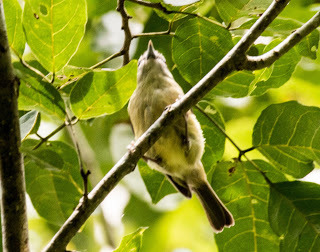 for and aft views of Blue mountain vireo, 2nd rarest bird on island,
for and aft views of Blue mountain vireo, 2nd rarest bird on island, 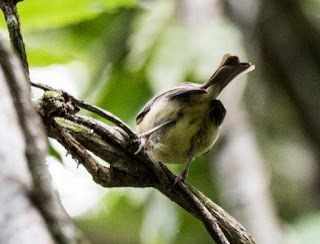 for and aft views of Blue mountain vireo, 2nd rarest bird on island,
for and aft views of Blue mountain vireo, 2nd rarest bird on island, 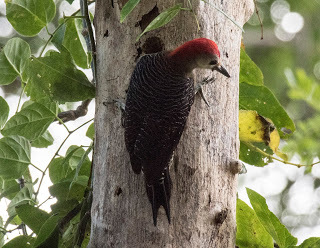 Jamaican woodpecker
Jamaican woodpecker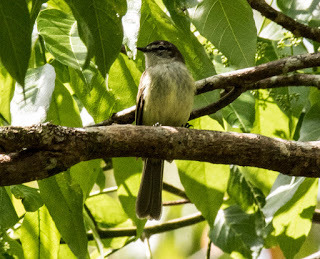 Jamaican elaenia
Jamaican elaenia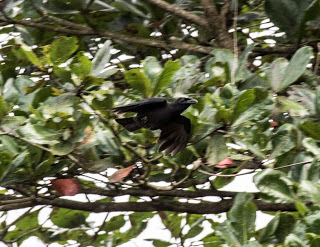 Jamaican crow, one of the coolest sounding corvids
Jamaican crow, one of the coolest sounding corvids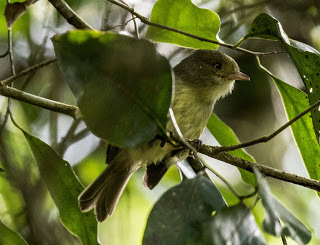 Jamaican vireo
Jamaican vireo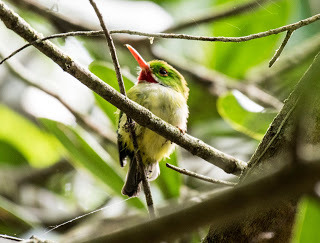 Jamaican tody wrapped up in a spider web
Jamaican tody wrapped up in a spider web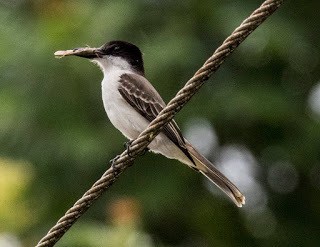 Loggerhead kingbird, present on most of the larger lslands
Loggerhead kingbird, present on most of the larger lslands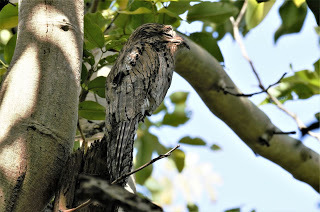 Northern potoo
Northern potoo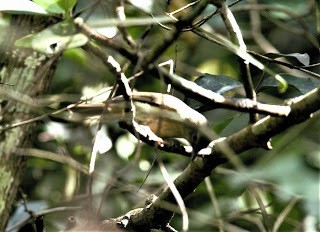 bad picture of a female orangequit
bad picture of a female orangequit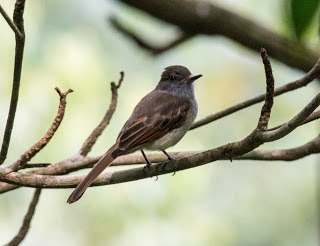 rufous tailed flycatcher
rufous tailed flycatcher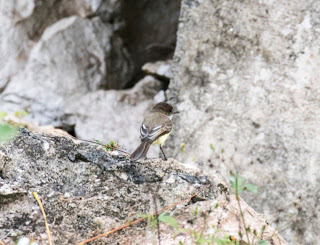 sad flycatcher, it might be sad due to all the garbage, otherwise I'm not sure on origin of the name
sad flycatcher, it might be sad due to all the garbage, otherwise I'm not sure on origin of the name Streamertail (red-billed) the national bird and not easy to always see
Streamertail (red-billed) the national bird and not easy to always see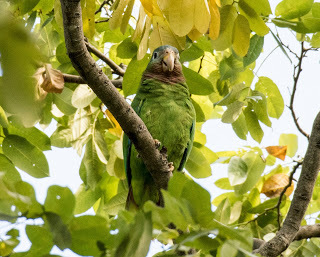 yellow billed parrot
yellow billed parrot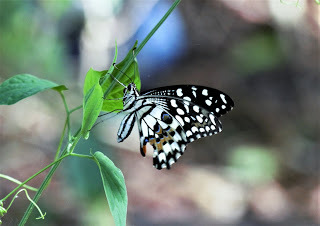 Invasive Lime swallowtail, pretty but working its way to Florida to harm the citrus industry
Invasive Lime swallowtail, pretty but working its way to Florida to harm the citrus industry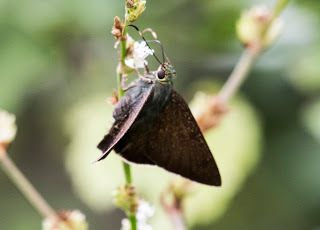 A butterfly I had not identified at writing this but was told by a reader it was a Jamaican flasher, a butterfly apparently named after me
A butterfly I had not identified at writing this but was told by a reader it was a Jamaican flasher, a butterfly apparently named after meGreat birds, couple bugs, some red stripe but I'm still unsettled
So do we start a Go Fund Me page for Wendy and her rehab center? Call it Operation Jamaica. The place needs surgical help, time to operate.
Do you want her Paypal email account to send her money?
Contact me
Olaf
Published on February 04, 2019 16:31
January 28, 2019
Woodstars, beers,and beaches
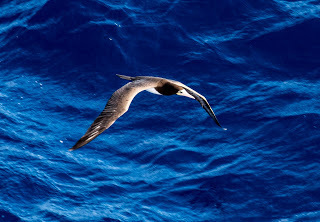
Today is my third day at sea. It has been a bit of a secret that I’ve been up to something. I’ve got my annual trip to Texas’s Lower Rio Grande Valley, later next month I fly to Uruguay and then expect to begin the voyage to secure such interesting birds as the South Georgia pipit and the inaccessible island rail. In March I’ll be in Africa, and then we’ve book a trip down the Colorado for June. This may or may not end up as an adventure book, I’m not sure yet. Two weeks ago I was in Curacao, tomorrow, I’ll be in Jamaica, yesterday I stopped off at a small private island owned by Carnival Cruise lines. This is no regularly scheduled cruise, in fact, it is a private charter, sort of a theme cruise for lack of a better description, which I won’t elaborate, you’ll have to buy the book, if there is one. This isn’t a birding cruise, although for me, it is, that is all I’ll admit to, nor is it a quilting charter.Little San Salvador is small and generally dry. There was little in bloom now and since my main goal was to find a Bahama woodstar, the Bahamas endemic hummingbird, and as such, I was in trouble. It was going to be a difficult find. For other species, it was clear that the island was not very birdy. I walked the nature trail and saw my first bird, a red junglefowl, the local wild chicken. It snuck off into the scrub without me getting a picture. If there is any thoughts of whether these chickens are wild, think again. It was easier seeing the doves out in the open than any of these birds. They make the Key West chickens, which look the same, seem tame. Tick! (I guess, I have the Kauai junglefowl so it isn’t a lifer bird anyhow. It was seeing the second bird of the day that became difficult. I walked, backtracked, got passed by joggers, honked at by tour buses, and saw nothing. Then near the horse farm and stables, I saw two junglefowl making a break for it across the pasture. They slowed down a bit in the middle and then scurried to cover on the other side of the fence. I’d never seen chickens move so fast. I guess the slow ones are called …stew.
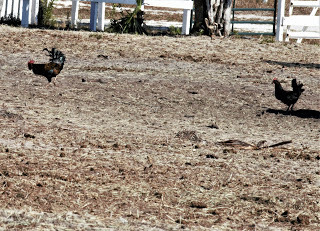 Red junglefowl, a long ranged photo but the best I got, and I saw thirty or forty of the birds. The chicken is a countable bird, I suppose, they have been here for at least 150 years.They had seed feeders up on the nature trail but this appeared to be mostly for the doves. It was good I stopped to see the chickens as I heard a quiet melodious song, I looked around and then I saw the long tail below me. A Bahama mockingbird was looking at me. This is a larger mockingbird than the one we see in the USA and it lacks wing-bars. This species occasionally ends up in Florida where I have seen one.
Red junglefowl, a long ranged photo but the best I got, and I saw thirty or forty of the birds. The chicken is a countable bird, I suppose, they have been here for at least 150 years.They had seed feeders up on the nature trail but this appeared to be mostly for the doves. It was good I stopped to see the chickens as I heard a quiet melodious song, I looked around and then I saw the long tail below me. A Bahama mockingbird was looking at me. This is a larger mockingbird than the one we see in the USA and it lacks wing-bars. This species occasionally ends up in Florida where I have seen one.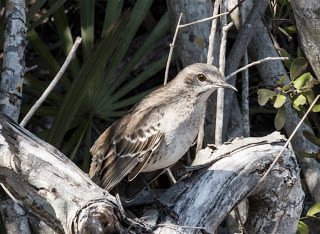 Bahama mockingbird It was near the Pegasus Ranch where they keep the horses, when I started to dig out a few birds. I tallied a Cape May warbler, a Midwest summer bird, and the Bahamas subspecies of the Bananaquit, which look nothing like the ones in Curacao. The birds in Curacao even have wing-bars and to my eye, fly and act differently. They are larger, too. I read a study on the genetics of the species and the Bahama birds diverged some time ago. They match the birds in Qnintana Roo, Mexico of all places. The species does not exist in Cuba.
Bahama mockingbird It was near the Pegasus Ranch where they keep the horses, when I started to dig out a few birds. I tallied a Cape May warbler, a Midwest summer bird, and the Bahamas subspecies of the Bananaquit, which look nothing like the ones in Curacao. The birds in Curacao even have wing-bars and to my eye, fly and act differently. They are larger, too. I read a study on the genetics of the species and the Bahama birds diverged some time ago. They match the birds in Qnintana Roo, Mexico of all places. The species does not exist in Cuba.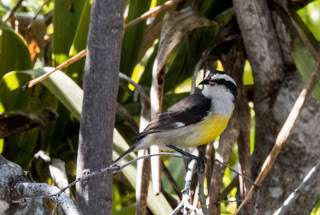 Bananaquit from the Bahamas
Bananaquit from the Bahamas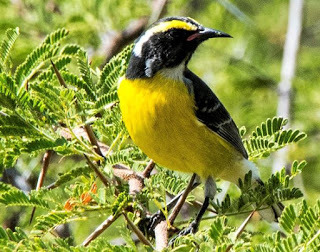 Bananaquit from Curacao
Bananaquit from CuracaoThere has been talk about splitting them into up to three species, as they have with Spindalis and a number of other species but they haven’t yet. Maybe soon? I doubt it but they really don’t look that much alike.
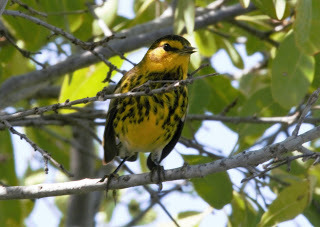 Cape May Warbler, Half Moon Cay, Bahamas
Cape May Warbler, Half Moon Cay, BahamasSo there I was. Looking at these warblers, when a Cuban pewee popped up and then looked and me and then dove into the bushes, never to return. I was about to give up on seeing a hummingbird when I saw the exact same tree with rather pungent odor surrounded by bees that I got my hummingbirds on in Curacao. I do not know what these bushes are called and the flowers have no color but the hummers sure love them. As I stood there, I heard a single chirp. A nice male Bahama woodstar lit not ten feet from me with the sun on it. It was stunning. Unfortunately, I was not ready with the camera. It took me a while to get my camera out as being around a bunch of naked people, lawyers, politicians, doctors, and businessmen, they get quite uneasy with Olaf and his big lens. Eventually without a good photo it disappeared. I was quite frustrated.I looked around and tried to phish a parula out of the bushes and then I thought of where my phone was. Where was my phone? The question became a panic. I was making an ebird list, so I had it out, but when and where?. I looked in my backpack, then emptied my backpack. It was nowhere to be found. I swore. Then I began a laborious backtrack to where I saw the mockingbird a couple hundred yards away. Luckily there it was, just a few feet off the road, and nobody saw it and helped themselves. I was really lucky. Did I mention my team of guardian angels…Even odder was when I looked at my pictures of the mockingbird. I had one picture with my cell phone in it. If I hadn’t found it, that would have bothered me for a long time, a very long time.
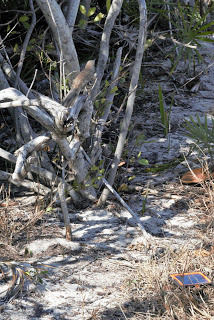
Bahama mockingbird upper center, cell phone lower right
I stood on the road and then behind me, world lifer #1054 lit on a branch, Bahama woodstar. It was like the hummingbird gave me a break.
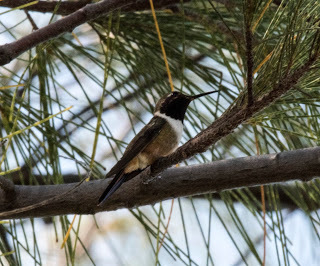 Bahama woodstar
Bahama woodstarI was hot, tired, thirsty, and well, did I say thirsty. I’d had enough birding. I decided to celebrate with a beer. I went to find Stuart, who was watching our beach chairs and stopped to see our ship out in the bay.
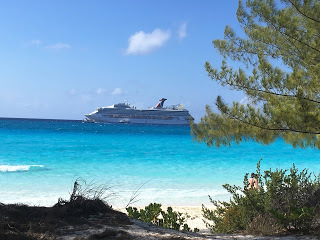
Drinking my beer, I though, birds, beer, and a sunny beach….someone texted me that it was -26 at home….ah, home, this idyllic moment made one temporary forget about home, but life moves on and so does Olaf. Tomorrow my Facebook friend Wendy is taking me birding in Jamaica. An island where everything will be a lifer bird. How many Red Stripes can a guy drink?
Published on January 28, 2019 12:08
January 14, 2019
Olaf's Goat
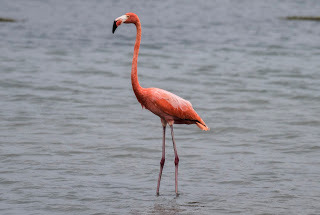 I watched a white-tailed hawk, the fourth one I’d seen on Curacao, fly over my head and I watched it disappear into the distance going straight toward the airport as if telling me something. It was time to go. I walked down bid farewells to our friends and Silja and I headed to the airport and our flight home. Our trip was over and it seemed simple enough to go home.Nine hours later an urgent call for any medical personal on board the American Air flight 149 to Minneapolis caused me to stir from a nap. Before I could respond, six people went forward and five minutes later the 737 went into decent, and then a 180 degree bank and the captain put it down fast into St. Louis landing hard and then a minute later we were at the gate as EMTs came aboard and escorted the passenger out. One never knows how travels will end and I guess the hawk was warning me about my trip. We took off two hours later and we cuddled up in a motel room at 2am in Minneapolis, 3 hours late and exhausted. It was a reminder of what will be. 2019 will be a year of thousands of miles of trips, trips by boat, bike, plane, RV, raft, including five continents, and hopefully no mishaps but travel is what travel does, one never knows...you just hope to get home, that is the adventureThe first trip was over, Curacao....at the northern edge of the continental shelf of South America....
I watched a white-tailed hawk, the fourth one I’d seen on Curacao, fly over my head and I watched it disappear into the distance going straight toward the airport as if telling me something. It was time to go. I walked down bid farewells to our friends and Silja and I headed to the airport and our flight home. Our trip was over and it seemed simple enough to go home.Nine hours later an urgent call for any medical personal on board the American Air flight 149 to Minneapolis caused me to stir from a nap. Before I could respond, six people went forward and five minutes later the 737 went into decent, and then a 180 degree bank and the captain put it down fast into St. Louis landing hard and then a minute later we were at the gate as EMTs came aboard and escorted the passenger out. One never knows how travels will end and I guess the hawk was warning me about my trip. We took off two hours later and we cuddled up in a motel room at 2am in Minneapolis, 3 hours late and exhausted. It was a reminder of what will be. 2019 will be a year of thousands of miles of trips, trips by boat, bike, plane, RV, raft, including five continents, and hopefully no mishaps but travel is what travel does, one never knows...you just hope to get home, that is the adventureThe first trip was over, Curacao....at the northern edge of the continental shelf of South America....Twenty four hours earlier..... It was a dark and moonless night as I stood in the middle of a road four miles from our hotel looking and then taking pictures of a white-tailed nightjar resting on the side of the road illuminated by my headlights of the small rental car three feet to my right and I could count the bird. That evening, the last of our trip, I had this feeling that I was forgetting something, but I brushed it off. I did do something I’d never done before. I won a game of hearts. I not only won, I crushed it. We’d taught Jan and Stuart, friends from Florida traveling with us to play the game and for a few nights we played. At home, our son Allwin usually wins. He has a great strategy and my grandmother Lucille won before she died, me….? I lose and loose spectacularly. Not this time.
I walked to our room and then it hit me. “Damn!” I said. “I just remembered what I’ve been thinking I’d forgot. Do you want to go birding?”“Now? Are you drunk?” My wife went to the point. It was 10 PM. I was talking sober as I was sober, I was too keen on winning to keep up with the wine everyone else was drinking, and maybe that is why I won. So my wife and I went out driving around at night looking for nightjars and we found nothing, so we drove back and went to bed. I vowed to go out in the early morning since it was our last morning on the island and my last chance. Driving around on roads in the middle of the night birding....sheez. I actually saw the ultra rare barn owl before I stumbled upon my goal....
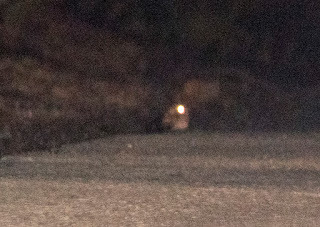 white-tailed nightjar
white-tailed nightjarThis was the last of nine Clements lifer world birds, or 11 for the IOC that I nabbed on Curacao, one of the ABC islands. The island has no endemic birds but it has some good ones from northern South America, like this nightjar that I needed, as I'd never birded South America before. I was born on the first day of Aries. therefore I am a goat and in Norse, Thorsbakken is my sacred animal, and as such, our eating got a little more adventuresome as the week wore on. My sacred animal became the fare of choice....For the first few days, adventure was ordering goat at the local bistro, we called the place the Fiesty Goat which was combination a store/ shack that also even featured live music on one day. The owner had invented the kabritu burger, or at least that is what the sign and the owner says. She is franchising the idea, and I’m not sure to whom or to where..
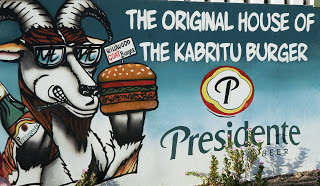 This burger is otherwise known as a goat burger smothered in goat cheese.
This burger is otherwise known as a goat burger smothered in goat cheese. Another day, I ordered goat stew. This restaurant had it all, well all the concerns of a restaurant. Anthony Bourdain would have liked it. Most days, you never knew what you were eating, and you never were sure about what you’d have to pay for it. When in doubt, we assumed it was probably goat. Like all good tropical restaurants, you weren’t even quite sure if part of the building was just going to fall over, and you just hoped that part was not where you were sitting.
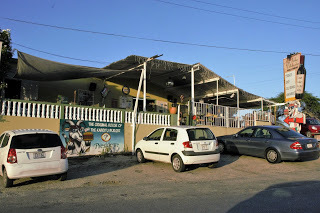
It seemed we just sat around eating goat every day on this adventure, but that was not true. I knew that a world lifer bird I needed was hanging out at the island’s golf course. The security guard let us in to the course under the auspices that we were going golfing and took my drivers license for collateral, made a copy and gave it back. All the gates here took licenses and car tag information down. St. Martin could learn a thing or two, from these people. You better have a good story or they won't let you in.Once in, I drove around and near a sand trap easily found our quarry, a southern lapwing, a really cool looking bird. There is some issue with me figuring out which number lifer it is as I haven’t finished my checklists yet. My goal before Uruguay is to get this organized. I think I may just negate some of my birds.
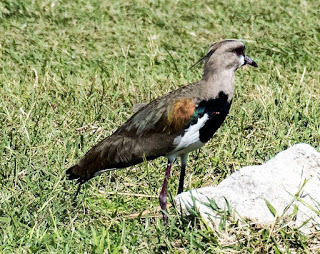 Southern lapwing, world lifer #1047, under Clement or so I think.
Southern lapwing, world lifer #1047, under Clement or so I think.It is place not designed for birders as parking is difficult and everything is private. Golf balls go shooting around everywhere, and I wasn’t even sure what hole I saw a pair of these birds on but I avoided errant shots and got out before the marshal and the security guards threw me out. I didn’t want to ruin it for the next birder.Our time on the island became an idyll. Stuart listened to podcasts and baked in the sun. Silja and Jan read novels and travel essays by people doing similar things to us, even one by Paul Theroux, Deep South which hit home as we had just been where he was at. We found small beaches with simple restaurants, fed feral cats, and watched people snorkel off of the South American Continental shelf. We also visited beaches lined by poisonous trees, which in one case had been painted like an octopus. Do the fruit and bark kill you or just make it so that you wish you were dead? We didn’t find out, luckily.
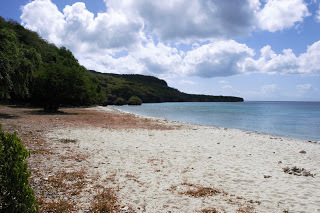
We found abandoned resorts, and looked at the scrub and hills which reminded me of the Edwards plateau of central Texas, complete with cacti and caracaras
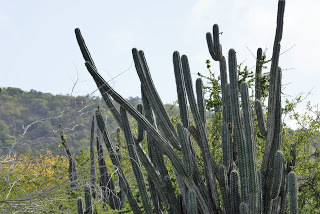
And not to forget the birds....stunningly beautiful birds
Lifers.......
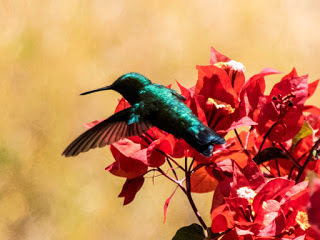
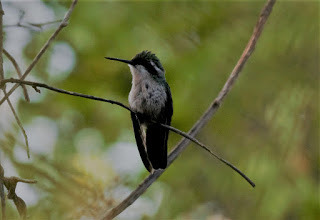 Blue tailed emerald (male and female below)
Blue tailed emerald (male and female below)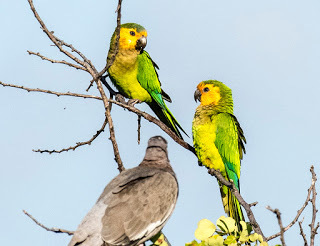 Brown-throated parakeet
Brown-throated parakeet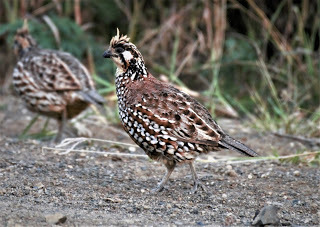 crested bobwhite
crested bobwhite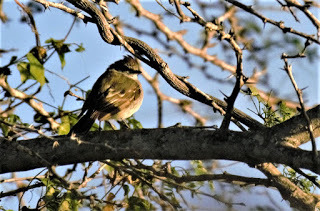 northern scrub flycatcher
northern scrub flycatcher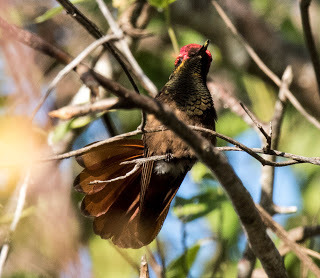 ruby-topaz hummingbird
ruby-topaz hummingbird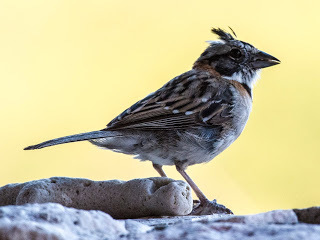 rufous-collared sparrow
rufous-collared sparrow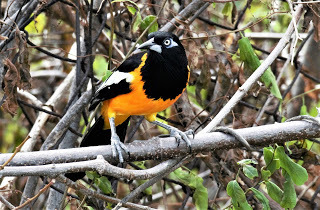 Venezuelan Troupial
Venezuelan Troupial 9 lifers and 2 IOC lifers, these two, a Cayenne tern, no picture, and mangrove warblers which were everywhere
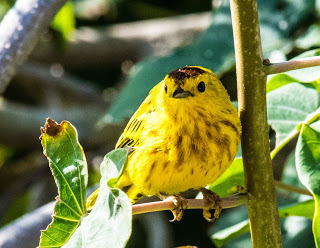
The island has other birds I've seen like Yellow orioles

American flamingos were easily found at two locations
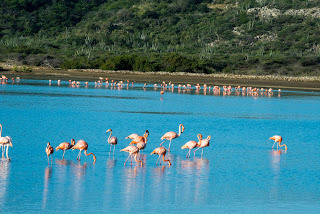
and other critters like the Miller's long-tongued bat which was the only thing that found my hummingbird feeder, the ass-faced toad, and Florida whites, Gulf fritillary butterflies, and hanno blue butterflies, a lifer butterfly
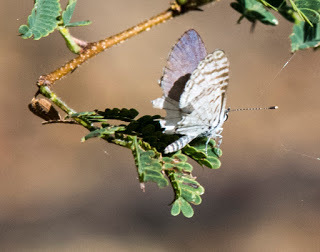
So a perfect trip...sun, sand, surf, birds, beer, butterflies, toads, bats, cats......and I guess goats...
and we also got home despite ....a scare
Curacao, a surprising hidden gem, don't be afraid to go...we'll go back, it is even safe to eat the goat
Olaf
Published on January 14, 2019 16:22



